Canon 7s
The Canon 7s is a 35mm rangefinder camera made in Japan by Canon from 1965-1967,[1] replacing the Canon 7. Lenses are interchangeable using either a bayonet mount (identical to that for the Canon 7, and only used for the 50mm f/0.95) or a 39mm screw. The shutter is a focal plane device with speeds from 1s to 1/1000s.
There is a built-in coupled light meter, with a scale on the top plate; this only provides for film speeds up to 400 ASA.
There are two major variants of the Canon 7s. The earlier version, of which Peter Dechert estimated as many as 16,000 were made (from February 1965 to around August 1967) can quickly be recognized: its small, circular rangefinder adjusting port is next to the shutter-speed dial. The later version, made until September 1968, has this adjusting port in an entirely different place: over the second "n" in "Canon 7s" on the top left (rather than top right) of the camera as held by the photographer. Dechert estimates that only 4,000 or so of these cameras were made.[2]
The change from the earlier to the later version was not announced by Canon, so the redesign is surprising. Dechert explains it as the necessary result of an unannounced but major improvement to the finder. As this was Canon's final rangefinder camera, Dechert named it the "7sZ", and this name has continued to be used (although not consistently, and certainly not by Canon). Dechert describes the improved finder as having much less trouble with ghost images, and as being generally clearer. He terms the 7sZ "the pinnacle of Canon's rangefinder camera design to date".[2]
Most of the examples of the earlier variant of the 7s (that with rangefinder adjustment near the shutter-speed dial) have a rewind knob that can be partly retracted into a slight recess in the top plate. Most, perhaps all examples of the 7sZ have a larger rewind knob: easier to use, but of too large a diameter for partial retraction into this recess (whose size is unchanged).[2]
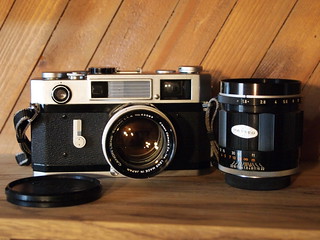
|
| 7sZ with 50mm f/1.4 and 85mm f/1.8 image by Hovsep Kevorkian (Image rights) |
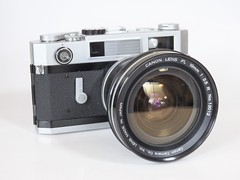 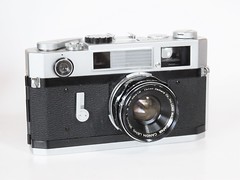 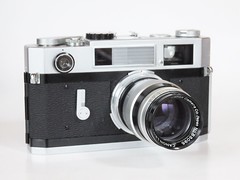 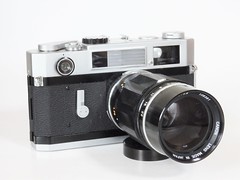
|
| Canon FL f3.5/19mm, f2/35mm, f3.5/100mm and f3.5/135mm lenses on a Canon 7s Images by yalluflex. (Image rights) |
Notes
Bibliography
- Dechert, Peter. Canon Rangefinder Cameras 1933–68. Hove, East Sussex: Hove Foto Books, 1985. ISBN 0-906447-30-5.
Links
In English:
- Canon 7s user manual at Manualslib
- Canon 7/7s/7sZ at Karen Nakamura's Photoethnography
- Canon 7s in the online Canon Museum
In French:
